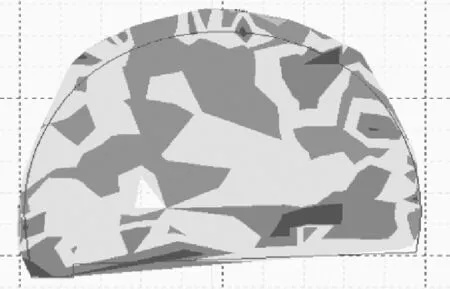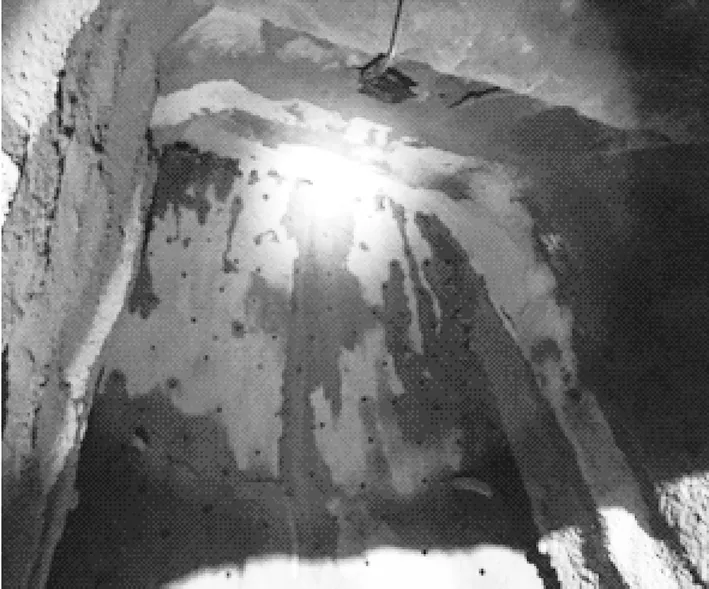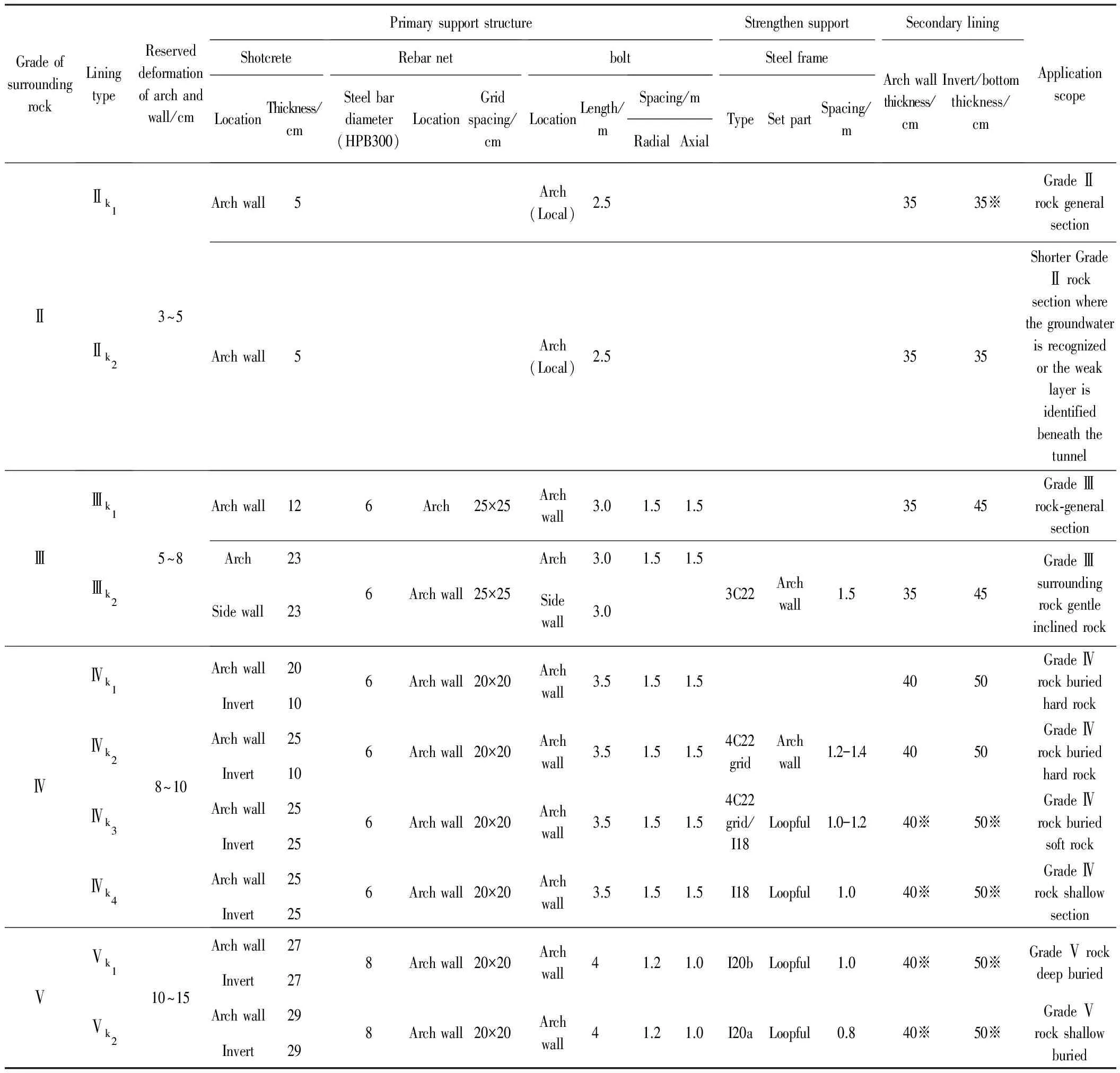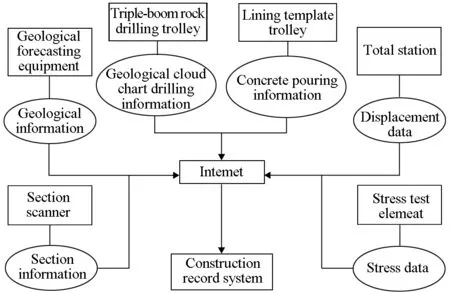Innovation and Future Application of Mechanized and Intelligentized Construction Technology for High-speed Railway Tunnels: A CaseStudy of Hubei Section on Zhengzhou-Wanzhou High-speed Railway
2018-04-19WANGZhijian
WANG Zhijian
(Wuhan-Jiujiang Railway Passenger Line Hubei Limited Liability Company, Wuhan 430200, Hubei, China)
0 Introduction
Currently, regarding the tunneling technology in China, the TBM method and shield method have been standardized and industrialized, while the mechanized, informatized and intelligentized construction of drilling and blasting method in mountain tunnel need to be improved[1]. Through continuous exploration and practice, the tunnel mechanized construction in China[2-4]gradually transfers from single mechanized process to whole construction process[5-6], and the level of mechanization keeps raising. However, the application of mechanized construction is mainly limited to surrounding rock of Grade Ⅱ and Ⅲ, while mechanized full-section excavation method have not being realized in soft surrounding rock of Grade Ⅳ and Ⅴ, so the promotion of construction speed is not significant. In informatized management of the mountain tunnel construction, although some informatied management platforms have been built, they are not applied to engineering practice and the coverage is not enough, and the overall level is not high enough, which leads to the fact that the collection of construction information is uncomprehensive, construction quality control is insufficient, safety warning of construction is not timely, and can not evaluate the credit or reputation of the construction company objectively and reasonably.
Aming to improve the level of mechanization and informatization of tunnel construction in China, Zhengzhou-Wanzhou High-speed Railway Tunnel construction has carried out a series of exploration and innovation in construction technology, structural design and informatized management under the whole process and large-scale machinery disposition. In this article the experience of Hubei section on Zhengzhou-Wanzhou High-speed Railway construction are summarized, and the mechanized full-section excavation technology, tunnel structure design based on mechanized construction, tunnel informatized management, intelligentized construction technology are overviewed, to promote China′s tunnel construction technology.
1 Project Overview
The totall length of the Hubei section on Zhengzhou-Wanzhou High-speed Railway is about 287 km (the cross-section is shown in Fig. 1), and the design speed is 350 km/h. Hubei section contains 33 tunnels (the Xiangshuwan Tunnel crosses Chongqing and Hubei), 7 of which the length exceeds 10 km; the total length of tunnels is 167.619 km, accounting for 58.4% of the total length of Hubei section. The excavation cross-section area is about 150 m2, and the tunnel span is 15 m. The buried depth of the tunnel is generally 100-1 100 m, and the surrounding rocks are grade Ⅱ, Ⅲ, Ⅳ and Ⅴ, among which the ratio of the fractured surrounding rock of Grade Ⅳ and Ⅴ is over 60%. The tunnel is a single-tube double-track super-large span tunnel. The main design parameters of tunnel support structrue are shown in Table 1.

Fig. 1 Tunnel cross-section
Tunnels of Hubei section on Zhengzhou-Wanzhou High-speed Railway is constructed in the area where stratigraphic development is integrate, and the geological condition includes quaternary overburden layer, soluble rock, shale and red beds. Frequent and strong regional tectonic movement are reconginzed, and most of them are orogenic movement. Folds and faults are widely recongnized; and the line crosses the Tangbai water system of Hanjiang River and the first and second grade tributary flowing or main stream of the middle and lower reaches of the Yangtze River basin; the groundwater mainly consists of Quaternary pore water, bedrock fissure water and karst water classified as Class 3 and bad geology condition is mainly karst, bedding bias, rockfall and landslide.
The exposed strata along the line are relatively complete, ranging from the Proterozoic to the Cenozoic Erathem. The metamorphic rock strata of the metamorphic andesite, metamorphic sandstone, slate and quartz schist in the Early Proterozoic are mainly distributed from Xingshan to Baokang Section; late Proterozoic dolomite, sandstone and shale are distributed in Xinhua area of Shennongjia; the Early Paleozoic strata mainly consisted of Cambrian carbonate rocks, clastic rock interphase strata, Ordovician dolomite, limestone and other soluble rocks, Silurian shales and sandstones are mainly distributed from Xingshan to Nanzhang Section; Xingshan to provincial boundaries of Hubei, there are Permian, Triassic soluble rocks and Jurassic clastic rocks; and the Upper Triassic Xujiahe Formation is the main coal-bearing strata in this section. Devonian and Carboniferous strata are only partially visible. The Cretaceous and Tertiary strata are mainly distributed in the vicinity of Nanzhang and the basements of the Nanxiang Basin, and the lithology is clastic rock. The loose deposits of the Quaternary genesis are widely distributed along the line and are concentrated in the Nanxiang Basin and low-lying areas. The thickness of the overburden in the Nanxiang Basin is generally greater than 50 m, and the rest of the area is relatively thin. The magmatic rock is exposed only in the middle of Xinhua Tunnel with a small rock mass.

Table 1 Main design parameters of tunnel support structure
Remark: ※ reffers to reirrforced concrete.
2 Full-section mechanized tunnel construction technology
The mechanization construction of tunnels on Zhengzhou-Wanzhou High-speed Railway is systematic and in large scale. The machine arrangements including the conventional disposition and the reinforced disposition. (1)The conventional configuration mainly includes pneumatic drill, multifunctional drilling and blasting operation bench, concrete wet spraying machine, self-propelled invert trestle, invert longitudinal sliding mode, concrete conveying vehicle and integrated
groove template trolley. (2)The configuration of the reinforced disposition adds two triple-boom rock drilling trolleys, a self-propelled hydraulic arch-mounted trolley, a water-proof plate operation trolley, a lining template trolley and a movable concrete health maintenance platform on the basis of the conventional disposition, as shown in Fig. 2. There are 15 tunnels, 24 working areas and the construction of 91.135 km tunnels are equipped with reinforced disposition in Hubei section; and 6 tunnels are equipped with conventional machinery.

Fig. 2 Machinery disposition during tunnel construction
The advanced geologic forecasting system TSP203PLUS produced by Amberg Technologies of Sweden (as shown in Fig. 3), the ground penetrating radar produced by Mala Sweden(as shown in Fig. 4) and computer-controlled triple-boom rock drilling trolley (as shown in Fig. 5) are used for advanced geological forecasting. The 3SNS-A plunger grouting pump (as shown in Fig. 6) is adopted.

Fig. 3 Advanced geologic forecasting system TSP203PLUS

Fig. 4 Ground penetrating radar
2.1 Advanced geological prediction technology: Comprehensive prediction + atomatic drilling parameters analysis
The advanced geological prediction technology combined with geological survey method, TSP seismic wave method, geological radar method, advanced blast hole drilling and deepening and other means, is a comprehensive forecasting technology. Among them, computer-controlled triple-boom drilling trolley is used to achieve advanced blast hole drilling and deepening, real-time monitoring of propulsion speed, impact pressure, propulsion pressure, rotary pressure, pore water pressure, water flow and other parameters, recorery of geological conditions by MWD(as shown in Fig. 7), and geological report generation, based on which big database of geologrcal conditions can be established.

Fig. 5 Computer-controlled triple-boom rock drilling trolley

Fig. 6 3SNS-A plunger grouting pump

Fig. 7 MWD geological nephogram
2.2 Advanced pre-reinforcement technology of excavation face: Conventional reinforcement + high pressure splitting grouting for Grade Ⅴ surrounding rock
The advanced pre-reinforcement methods of excavation face include excavation face closed by shotcreting, reinforcing excavation face by GFRP bolt, advanced pipe-shed support and advanced grouting reinforcement. Among them, the high pressure splitting grouting method is used to prereinforce the weak surrounding rock of Grade Ⅴ. The maximum grouting pressure of the 3SNS-A piston-type grouting pump could reach 10 MPa and form the skeleton structure by squeezing the adjacent soil, thus effectively strengthening of the weak surrounding rock before the excavation face can be realized. The comparison between pre-reinforcement effect and high pressure splitting grouting effect is shown in Fig. 8.

(a) Before grouting,the excavation face is unstable

(b) After grouting,the excavation face is stable
Fig. 8 Comparison between pre-reinforcement effect and high pressure spliting grouting effect
2.3 Full-section mechanized excavation method
Using the machinery disposition, three sets of new construction methods are formed, including full-section excavation method (with invert), large cross-section excavation method (without invert) and micro-bench excavation method. The characteristics and applicable scope for various grades of surrounding rock are shown in Table 2.
Table 2 Characteristics and applicable scope for various grades of surrounding rock

MethodCharacteristicsApplicablescopeofsurroundingrocksFull⁃sectionexcavationmethod(withinvert) Theblasthole,blastingandmoldingandmuckingarefinishedonce.Theprimarysupportisfin⁃ishedonceⅡ,ⅢandⅣLargecross⁃sectionexcavationmethod(withoutinvert) Dividedintotwiceblastingforarchwallareaandinvertarea.ConsturctingtheprimarysupporttwiceⅡ,ⅢandⅣMicro⁃benchexcavationmethod Thelengthofthebenchonthearchwallis2-3m,theupperandlowerstepareblastedsimul⁃taneously.Constructingprimarysupportonce;invertareaisforthesecondaryexcavationandsup⁃portingⅤ
Through the application of the above new construction methods, the construction schedule has been greatly improved compared with that of the traditional excavation method, as shown in Table 3.

Table 3 Efficiency comparison of new construction methods
2.4 Mechanized construction technology of primary support
Triple-boom rock drilling trolley or bolt drilling and grouting trolley are used to install the bolt. Wet spray manipulator is used to spray concrete. Steel arch frame is implemented by a self-propelled hydraulic arch-mounted trolley. Among them, the initial tension and full grouting of prestressed hollow grouting bolt are measured (Fig. 9) to guarantee the active support effect of the bolt, and exert the rock′s self-bearing capacity. Meanwhile, the installation of a single bolt takes about 5 minutes, which is 1/3 of the time used to install the traditional bolt, which greatly saves the process time.

(a) Stress monitoring

(b) Grouting fillings test
2.5 Construction technology of wide waterproof board
Waterproof board operation trolley is used to pave wide waterproof board (as shown in Fig. 10), which fulfills the requirements for wide laying of the waterproof board, and effectively reduces the seams. By automatically spreading and leveling of the waterproof board, the labor intensity is reduced, the laying efficiency is improved, also the welding and fixing of the hot-melt gasket are facilitated, thus the construction quality is ensured.

Fig. 10 Waterproof board operation trolley
2.6 Intelligentized lining trolley
On the basis of skeleton-free lining trolley, a new type of intelligentized lining trolley (as shown in Fig. 11) has been invented with the following features.
(1)The intelligence and informatization of lining trolley. The system can automatically calculate the theoretical volume of concrete required for pouring of lining section, monitor the real-time concrete pouring volume, temperature and pressure, and monitor real-time concrete pouring situation using infrared video system to achieve trolley lap end limit automatic alarm. Local and remote wireless remote control hydraulic positioning system is used to automatically generates a data report for each lining cycle.
(2)Optimization of automatic material distribution system: The automatic material distribution system adopts the rotating mechanism and electronic motor to control the positioning and PLC and wireless remote controller to control the tube changeover, so as to realize pouring concrete with pressure.
(3)Optimization of vibrating system of lining trolley: Four groups of automatic insertion vibration system are set up in the vault of the lining trolley, which ensures the compaction of the vault concrete.
(4)Optimization of lining trolley operating platform: The main optimization measures are increasing the installation angle of the ladder, the width of the ladder and the effective width of the platform to make the construction more convenient.

Fig. 11 Optimization of intelligentized lining trolley operation platform
3 Tunnel structure design based on mechanied construction
3.1 Tunnel surrounding rock classification
The tunnel surrounding rock is divided into two parts, i.e., tunnel body and excavation face. There are qualitative method and quantitative method for the sub classification of surrounding rock of tunnel body. The qualitative indices refer to rock hardness and rock integrity,while the quantitative index refers to the basic quality index of surrounding rock (BQ). The sub-classification of the surrounding rock of railway tunnel is shown in Table 4. On the basis of Table 4, combining with the specific conditions of tunnel, the sub-classification is corrected with the factors such as groundwater state, strike-dip of main structural surfaces and initial ground stress state. Through comparative study, the corresponding relationship between the sub-classification of surrounding rock and the classification of Q method is obtained (as summarized in Table 5).

Table 4 Sub-classification of surrounding rock of railway tunnel

Table 5 Corresponding relationship between sub classification of surrounding rock and Q method
Using the geological sketch of the excavation face, advanced geological forecasting and digital imaging technology to obtain rock hardness, rock integrity and groundwater status of excavation face; the excavation face stability is divided into three categories, i.e., stable, relatively stable and unstable; and based on which a classification method of excavation stability(as summarized in Table 6) is formed.

Table 6 Excavation face stability classification method
3.2 Research on design parameters optimization of tunnel support structure
Based on theNewAustrianTunnelingMethod, the surrounding rock and initial support are considered as the bearing body in the design of tunnel support structure, which bears all the load of surrounding rock, while the secondary lining is considered as a safety reserve.
Through in-situ monitoring of construction process of full-section mechanized excavation, tunnel support structure has the following characteristics: (1)The composite structures including bolts, steel arch, steel arch / grille + spray concrete are in safe and controllable state. (2)The contact pressure of surrounding rock is less
than the value in the code; under the deep buried conditions, the vertical load is about 20% of the value in the code; the horizontal load of Grade Ⅳ is about 80% and that of Grade Ⅴ is about 30% of the value in the code, respectively; the measured lateral pressure coefficient is about 0.8-1.0. The results show that the supporting system of the tunnel could be optimized under the condition of full-section mechanization.
Furthermore, through numerical simulation, the safety of optimized primary support structure and secondary lining in surrounding rock of grade Ⅳ and Ⅴ are calculated. The results meet the requirements of the code. The main design parameters of tunnel support structure are shown in Table 7.

Table 7 Main optimization design parameters of tunnel support structure
Remark: ※ reffers to reirrforced concrete.
4 Informatized management of tunnel construction
4.1 Construction management system
In order to solve the problem that the tracing of laborer pricing data, the connection of the image of engineering entities and the inspection lot and the bad control overspending and overcapacity, the process control method of labor inspection and pricing is proposed. The core idea is: relying on the internet technology, BIM modelling and fine management; dividing the project into various process controling units and connecting each process control unit with the number of construction drawings, bill of quantities, quality inspection lot and project image. The specific process is shown in Fig. 12.

Fig. 12 Specific process of construction management system
4.2 Construction information collection system
The construction information mainly includes electronic engineering geological map, drilling and bolt records, high-pressure grouting record and excavation cross-section headroom measurement.
The construction data of the tunnel has many characteristics such as huge number of collection points, large amount of information and high requirement of real-time. The data are transmitted on the internet and a tunnel construction record database is established, in which the data is stored by classification of data sources. The construction records are displayed by web forms, graphs and curves. The system is shown in Fig. 13.

Fig. 13 Construction information collection system
4.3 Construction safety management system
Relying on the rapid collection the advanced geological data, the convergence measurement data of surrounding rock, the tunnel displacement and stress data in the construction record system are collected to realize the information sharing and early warning, which is beneficial to the construction parties, supervision parties, designers and owners.
4.4 Quality management system of concrete mixing station
By using the quality management system of concrete mixing station, the whole process monitoring of concrete from raw material entry to mixing station production to the construction site are realized, that effectively ensures the quality of concrete.

Fig. 14 Concrete mixing station quality management system
4.5 Quality Control rating system
Based on the process quality, the evaluation system regarding with the excavation, primary support, secondary lining and four electrical interfaces is established. The system uses the construction process inspection, data of accepted process quality and third-party inspection data to quantify the quality of the project. By decomposing the quality evaluation of construction into the quality of raw materials, entity quality and process control, the data are used for evaluation and the credit evaluation is more scientific, fair, open and transparent. The specific processes are shown in Fig. 15.
4.6 Dynamic construction management system
After evaluating the tunnel design, geological forecasting, pre-reinforcement of excavation face, smooth blasting, primary support quality and monitoring measurement information in the information management platform, the excavation face is divided into three categories that includes controllable management, basically controllable management and uncontrollable management, as shown in Table 8.

Fig. 15 Quality credit rating system

Table 8 Evaluation method of construction dynamic management classification

Continued Table 8
Remarks: (1)The controllable working face is defines as: all 1-5 projects are controllable or no more than two of them are basically controllable, and there is no uncontrollable project; (2)The uncontrollable working face is defines as: once there exists uncontrollable project; (3)The basically controllable working face is defined as: there is no uncontrollable project, and more than two projects are basically controllable.
5 Prospect of intelligentized tunneling technology
The intelligentized construction is the advanced stage of informatized construction. It connects the sensors and information systems to form the internet of things based on informatizated and mechanized construction. By using cloud computing technology, the data fusion and processing analysis of obtained information are carried out to realize the integration of "digital tunnel" and internet of things online. After intelligent analysis and processing, intelligent response and decision support instruction are made to realize the construction technology of intelligent service.
5.1 Intelligent dynamic design system of tunnel support system
Based on digital imaging technology on the excavation face and drilling trolley′s drilling parameters, the tunnel excavation face and advanced geological information is obtained automatically, according to which, the classification of surrounding rock in the design stage is verified, and the subclassification of surrounding rock is carried out automatically. According to the subclassification of surrounding rock, the stability of excavation face and advanced support design, the blasting design and the support structure parameters adjustment are automatically carried out to achieve fine dynamic design of tunnel.
5.2 Intelligent robot construction technology of tunnel support system
Based on mechanized, informatized construction technology and deeply integrated the internet of things technology, intelligent robot construction technology is developed, including the intelligent rock drilling robot that could the automatically designing layout, positioning and drilling of blasting hole on the excavation face. The intelligent bolt-installing robot is developed to realize the bolt automatically positioning, drilling, installing, grouting, locking and prestressing; and the bolt position and parameters are tagged with internet of things. The intelligent concrete spray robot is developed for automatically positioning, 3-dimentional contouring scanning, spraying concrete, spray profile monitoring and matching until the design requirements are met and automatically calculating the volume amount of shotcrete. The intelligent arch-mounting robot is developed to realize automatically intelligent positioning, 3D profile scanning to identify undercuts and automatically arch grabbing, positioning and connection bar construction.
5.3 Intelligent monitoring system of tunnel structure
The automatic and real-time monitoring of support stress during the construction are conducted regarding the safety issue of the construction and the structures of the tunnels. Three-dimensional model of tunnel support during construction is established with big-data method and the three-dimensional stability of the tunnel support is automatically identified and the corresponding engineering measures are preoposed.
6 Concluding remarks
Through continuous practice exploration and technology innovation, the construction of Zhengzhou-Wanzhou High-speed Railway Tunnel has basically been mechanized during the whole-process of full-section construction in all geological conditions and informatized during full-process of information management. In the future, by combining information network technology and big data analysis method, tunnel design, construction and management system, an intelligentized construction platform for high-speed railway tunnel can be built; and the beautiful vision of automatic and intelligent tunnel construction will be truly realized.
:
[1] GUAN Baoshu. Tunneling by Mining Method: Lecture ⅩⅪ: Mechanization of tunnel construction[J]. Tunnel Construction, 2016, 36(10): 1163.
[2] ZHU Qinsheng. Study of application of 3-boom hydraulic rock drilling jumbos in construction of Jiaozhou Bay subsea tunnel in Qingdao[J]. Tunnel Construction, 2010, 30(6): 670.
[3] ZHAI Fuqiang. Application of robot-executed wet shotcreting technology in long tunnels[J]. Tunnel Construction, 2010, 30(S1): 346.
[4] KANG Baosheng. A new type of steel rib installing machine used in tunneling[J]. Tunnel Construction, 2011, 31(5): 624.
[5] ZHOU Rong. Optimization and study of allocation of drill and blast excavation equipment for high-speed railway tunnels[J]. Journal of Railway Engineering Society, 2016, 33(12): 82.
[6] XU Wenchao, TANG Xiangao. Mechanical matching for double-track railway tunnels constructed by drilling-and-blasting method and analysis on its applicability: Case study of tunnels on Guiyang-Guangzhou Railway[J]. Tunnel Construction, 2013, 33(6): 431.
[7] Code for design of railway tunnel: TB 10003-2016[S]. Beijing: China Railway Publishing House, 2016.
杂志排行
隧道建设(中英文)的其它文章
- Statistics of Railway Tunnels in China as of 2017
- 高速铁路隧道支护参数的计算研究
- 2018年世界隧道大会暨国际隧协(ITA)第44届年会将在迪拜举办
- Chinese Longest Sea-crossing Metro Tunnel:Wuyuan Bay Station-Liuwudian Station Section of Xiamen Metro Line #3
- Extra-large Undersea Shield Tunnel in Composite Ground:Maliuzhou Traffic Tunnel in Zhuhai
- Construction Technologies for Tunnels in Special and Complicated Geology of Lanzhou-Chongqing Railway
